|
MID
SPRING UPDATE
- MAY 2009
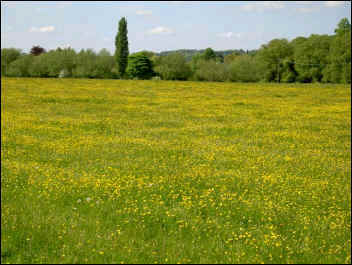
In
the March update, I expressed concern about a repeat of the poor
weather experienced in April/May the last two seasons, but we have
made it into early May with a far more balmy setting. And this has
certainly had a beneficial affect on our wildlife. As the hints of
sporadic green sheen in our trees-capes evolved into an explosion
of every shade of green one can imagine, so the emergence of
larvae, caterpillars and flying insects followed, just in time for
arriving migrant birds.
Not
that even in early May they had all arrived; with only one report
of a Cuckoo calling (thanks to Pam Knight), and just a
handful of Swifts and House Martins so far, it seems
the main bulk of aerial arrivals is yet to hit us. However,
‘our’ Hobbies have been back a short while now,
commencing their patient wait for the first Crows to finish
with their nests. Despite all the hard work undertaken to get to
us every year, Hobbies seem lazy when it comes to nest
building and far prefer to wait for a suitable home to be vacated,
and a Crow’s nest is ideal, being just the right size and
invariably high up in a tree and away from other large bird’s
nests.
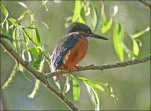 Several
warbler species could be heard by end of April, with Blackcaps
and Chichaffs most prominent, followed later by a few Whitethroats,
whose scratchy renderings could be hard around Cockmarsh and
Strand Water in the last week of the month. But it was early May
before good numbers of Sedge and Reed Warblers were
noted, mostly on nearby waters such as Jubilee River as, due to
essential dredging of some of our local streams, reeds are yet not
established enough to attract these two skulking species. One
small area of reeds at the CIM end of Strand Water however has
hosted a singing male for the last few days, his grasshopper-like
calls aimed at attracting a female to join him. Already on this
water, the three or four Coots nests had provided the first
chicks of the season by May 1st. John Lloyd-Parry has
been observing a pair of Kingfishers around the Widbrook/White
Place Farm area so hopefully they too have a nest nearby. He had
seen both Greylag and Canada Geese with young and
also found a Long-tailed Tit nest. Often these birds have
young by April but I found 2 other pairs still building nests in
the first few days of May, so they seem later this season. Several
warbler species could be heard by end of April, with Blackcaps
and Chichaffs most prominent, followed later by a few Whitethroats,
whose scratchy renderings could be hard around Cockmarsh and
Strand Water in the last week of the month. But it was early May
before good numbers of Sedge and Reed Warblers were
noted, mostly on nearby waters such as Jubilee River as, due to
essential dredging of some of our local streams, reeds are yet not
established enough to attract these two skulking species. One
small area of reeds at the CIM end of Strand Water however has
hosted a singing male for the last few days, his grasshopper-like
calls aimed at attracting a female to join him. Already on this
water, the three or four Coots nests had provided the first
chicks of the season by May 1st. John Lloyd-Parry has
been observing a pair of Kingfishers around the Widbrook/White
Place Farm area so hopefully they too have a nest nearby. He had
seen both Greylag and Canada Geese with young and
also found a Long-tailed Tit nest. Often these birds have
young by April but I found 2 other pairs still building nests in
the first few days of May, so they seem later this season.
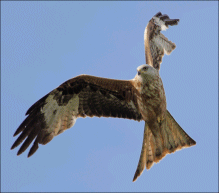 Buzzards
had finished their dramatic diving displays by end of April as
females settled on nests, there being at least two, and possibly
three around the village. I’m not too sure what is happening on
the Kite breeding front however as there is so much
continued tussling and play going on in the skies above, it is
hard to separate genuine courtship behaviour from the ‘play’
of the many young birds which have remained to summer in the
Cookhams, 41 still soaring together on May 2nd. Martin
Glover’s fine shot shows a sub-adult bird far from in its
breeding prime, with several damaged primary feathers and one or
two still being replaced. Buzzards
had finished their dramatic diving displays by end of April as
females settled on nests, there being at least two, and possibly
three around the village. I’m not too sure what is happening on
the Kite breeding front however as there is so much
continued tussling and play going on in the skies above, it is
hard to separate genuine courtship behaviour from the ‘play’
of the many young birds which have remained to summer in the
Cookhams, 41 still soaring together on May 2nd. Martin
Glover’s fine shot shows a sub-adult bird far from in its
breeding prime, with several damaged primary feathers and one or
two still being replaced.
It
is often plants which give the first indication of spring of
course, and both Quarry and Bisham Woods were displaying fine
patches of heady-scented Bluebells by the end of April,
whilst the leaves at least of Wood Sorrel and Dog’s
Mercury were in profusion. Emphasising the importance of the
‘scruffiness’ of our way-side vegetation, the dainty flowers
of Forget-me-nots and Speedwells deserve far more appreciation
than our oft-hurried walks past them afford. Meanwhile, the whole
area surrounding the village turned yellow this month with
Widbrook bathed in Buttercups, Dandelions and Daisy
centres, whilst adjacent fields held Rape, Field Mustard
and variety of Hawkweeds. Hedges on the other hand were
turning white as Hawthorn blossom, with its distinctive
aroma, came into its own. There have been some white splashes in
some hedges a few weeks ago, but these will have been the flowers
of Blackthorn, which bloom prior to the budding of their
leaves, unlike Hawthorn which reverses this process.
This
profusion of cover tempted early reptiles out of hiding and I
found 3 separate Grass Snakes and a beautiful Slow Worm
on my ramblings recently.
|
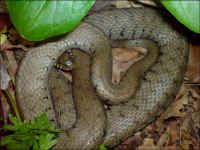
|
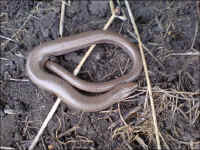
|
|
Grass Snake
BDC |
Slow Worm
BDC |
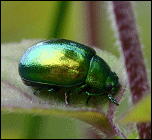 In
turn, the leaves and flowers tempted many insects out of
hibernation. During a 2-hour May-day amble around The Moor and the
immediate surrounds of Moor Hall, I found a number of creepy
crawlies in full swing. Nursery Web spiders had already
constructed their sealed pockets of silk where the imprisoned
females will rear their numerous young. A few ladybird
species were abroad, including the common 7-spot, the
notorious Harlequin, and my first 14-spot Ladybird.
Then there were incredibly iridescent Mint Beetles, and
several species which have never even been given an English name,
a great pity in my view and highlights the general decline in
entomology in our nation. I found Hister
unicolor, which should be named ‘Shiny Black Hump Beetle’
(or something like that), and a weevil Phylobious
pomaceus (Chameleon Weevil?) which is a different colour
depending on what way the sun is shining on it. Then there was Melachius
bipustulatus (which someone at last has named ‘Malachete
Beetle), with its sheen of green on its upper parts truncated
by a rich, matt salmon patch at the rear. It is difficult to
emphasis just how small some of these insects are and without a
slow, purposeful gait, and some optical aids, most will escape
notice. And I would also stress I know next to nothing about
insects, but pure curiosity ensures I have
to know what each new bug is, if I can find out through books and
internet. A bit time-consuming, but great fun, and gives each
creature discovered the proper respect of identification. In
turn, the leaves and flowers tempted many insects out of
hibernation. During a 2-hour May-day amble around The Moor and the
immediate surrounds of Moor Hall, I found a number of creepy
crawlies in full swing. Nursery Web spiders had already
constructed their sealed pockets of silk where the imprisoned
females will rear their numerous young. A few ladybird
species were abroad, including the common 7-spot, the
notorious Harlequin, and my first 14-spot Ladybird.
Then there were incredibly iridescent Mint Beetles, and
several species which have never even been given an English name,
a great pity in my view and highlights the general decline in
entomology in our nation. I found Hister
unicolor, which should be named ‘Shiny Black Hump Beetle’
(or something like that), and a weevil Phylobious
pomaceus (Chameleon Weevil?) which is a different colour
depending on what way the sun is shining on it. Then there was Melachius
bipustulatus (which someone at last has named ‘Malachete
Beetle), with its sheen of green on its upper parts truncated
by a rich, matt salmon patch at the rear. It is difficult to
emphasis just how small some of these insects are and without a
slow, purposeful gait, and some optical aids, most will escape
notice. And I would also stress I know next to nothing about
insects, but pure curiosity ensures I have
to know what each new bug is, if I can find out through books and
internet. A bit time-consuming, but great fun, and gives each
creature discovered the proper respect of identification.
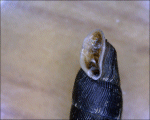
I
hope folk are already getting into the great ‘snail chase’
recommended on the Cookham Wildlife page of the village web site.
Even this early in the ‘slime season’, 3, 4 and 5-banded
snails of both the white-lipped and brown-lipped form could be
found on stinger beds all round the village; another reason to
leave these wilder corners strictly strimmer-free! There were also
the delightful all-yellow ‘plain-banded’ snail (bit
of a daft name that one!). But not all snails are at ground level.
Half way up the supporting wall of the railway bridge at the end
of the golf course I found a tiny, thin shell about 8mm long, with
an ear-shaped sucker secured to a small moss growing between two
bricks. This turned out to be Cochlodina
laminate after a bit of research and I had not seen one like
it before.
Of
the flying insects, a few Damselflies had emerged on the
warmer days (they generally need at least 17 degrees before they
bother), and as expected, Large Reds were the most
prominent, with a few Common and Azure Blues to
accompany them. These two can only be safely separated with a
clear look at the thickness of the blue line across the top of the
thorax, and the shape of the small black patch on the 2nd
segment of the abdomen; I said you need optical aids! I am
determined to find one of our region’s scarcer species, the White
Legged Damselfly this year, as they have been found not too
far away and some of our quieter waters ought to be ideal for
them. Again, do check the village web site for more details of
these dainty insects.
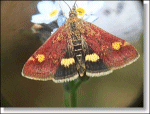 Butterflies
were restricted to Large and Small Whites, Peacocks
and early Commas for a while, but the delightful Holly
Blue was on the wing by end April, its deep, rich blue
upper-wing contrasting with its pale, grey-blue under-wing with a
smattering of tine black dots. The more colourful under-wing of
the Common Blue is not seen until a few weeks after the
Holly is abroad. Moths have been slow to get going this
spring, but my actinic and MV lights in the garden have attracted
a beautiful Herald, a Scorched Carpet, a few Waved
Umbers and lots of bright yellow Brimstones (smaller
and more patterned than the Brimstone Butterfly). Many moths are
day-flyers and I found the tiny Pyrausta aurata (or Mint Moth) on the wing yesterday. An
excellent resource to see the incredible range of moths is www.bike2nature.co.uk,
the web site of the Hampshire Moth group, where clicking on the
blue species number brings up a photograph of the insect. You will
be amazed at what goes unseen whilst we are sleeping! To emphasise
this point, a friend (Les Finch) has been studying the moths
around Beechingrove Wood, Cannon Court Farm, (both within our
parish boundary) and his home near Furze Platt, for 5 years and
has caught over 57,000 individuals of 320 species! Butterflies
were restricted to Large and Small Whites, Peacocks
and early Commas for a while, but the delightful Holly
Blue was on the wing by end April, its deep, rich blue
upper-wing contrasting with its pale, grey-blue under-wing with a
smattering of tine black dots. The more colourful under-wing of
the Common Blue is not seen until a few weeks after the
Holly is abroad. Moths have been slow to get going this
spring, but my actinic and MV lights in the garden have attracted
a beautiful Herald, a Scorched Carpet, a few Waved
Umbers and lots of bright yellow Brimstones (smaller
and more patterned than the Brimstone Butterfly). Many moths are
day-flyers and I found the tiny Pyrausta aurata (or Mint Moth) on the wing yesterday. An
excellent resource to see the incredible range of moths is www.bike2nature.co.uk,
the web site of the Hampshire Moth group, where clicking on the
blue species number brings up a photograph of the insect. You will
be amazed at what goes unseen whilst we are sleeping! To emphasise
this point, a friend (Les Finch) has been studying the moths
around Beechingrove Wood, Cannon Court Farm, (both within our
parish boundary) and his home near Furze Platt, for 5 years and
has caught over 57,000 individuals of 320 species!
So,
as spring leads us into summer, with increasing temperatures and
day-length, I wonder what else might be found around our
fascinating village. Do keep an eye out and let us know.
Brian
Clews
May
2009.
|
|







